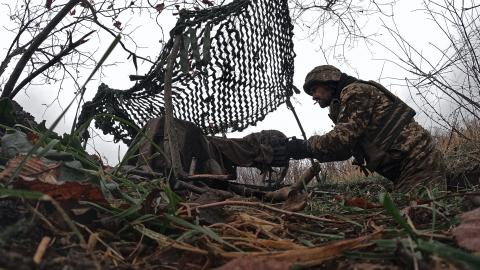Below Hudson Senior Fellow Can Kasapoğlu offers a military situation report about the war in Ukraine
Executive Summary
Fighting continues to intensify in Avdiivka, which has become the focal point of Russia’s offensive operations.
The Ukrainian military is working assiduously to develop a bridgehead on the left bank of the Dnipro River.
The FrankenSAM project holds the potential to boost Ukraine’s air defenses.
1. Battlefield Update
The past week featured high-intensity fighting coupled with increasing material losses. And while combat operations continued their intensive tempo, there were few changes in the control of terrain. Russian forces continued to concentrate their offensive efforts on Avdiivka in Donetsk Oblast and on the Oskil River sector of the Kupyansk-Kharkiv axis. Clashes also occurred in the Kherson sector.
Avdiivka, where the Russian high command is pushing combat formations to their limits, has become the focal point of the Russian invasion. Ukrainian forces repelled numerous attacks there on October 30 alone, as equipment losses mount and casualty counts spiral upward. While General Valery Gerasimov, the chief of the General Staff of the Russian Armed Forces, continues to press forward despite increasing bloodshed, concerns are arising that Avdiivka may soon play host to catastrophic attritional fighting of the sort that has plagued Bakhmut.
Communications between American and Ukrainian officials validate these concerns. During a phone call this week with United States Secretary of Defense Lloyd Austin, Ukrainian Defense Minister Rustem Umerov estimated that Russia has lost over 4,000 troops in the first few weeks of heavy fighting in Avdiivka, as Moscow sends human waves of military servicemen into the teeth of Ukrainian artillery.
Meanwhile, Russia continues to strike Ukraine’s critical infrastructure and population centers with missiles and Iran-designed Shahed-131 and Shahed-136 kamikaze drones. Despite the Ukrainian Air Force’s improving interception rates against these salvos, civilian targets in Ukraine have sustained heavy damage. Russia attacked non-military targets this week in both the Kherson and Kharkiv regions, but made no significant gains there.
2. Ukraine Faces Challenges of Logistics and Attrition
Russia’s recent offensives have been organized around a common strategy: to conduct envelopment attacks designed to capture Ukraine’s lines of logistics and isolate its forces. This suggests that Moscow aims to seize key transport routes and railroad junctions to use as springboards for a more comprehensive winter offensive against major population centers. It will struggle to do this effectively until it improves its ability to move supplies across Ukrainian territory and control key transport nodes.
While Ukraine has managed to hold main defensive lines along several fronts, the coming weeks will present challenges. The recent delivery to Russia of over 1,000 containers of North Korean military equipment and ammunition will likely strain Ukrainian defenses and allow Russia to more easily run large-scale combat operations. Russia will likely continue to press Ukraine on multiple fronts in an effort to tie down Ukrainian units that could otherwise be deployed elsewhere in more promising offensive operations.
3. Kyiv Continues to Hold a Bridgehead on the Dnipro
Ukrainian forces are gradually entrenching their presence along the left bank of the Dnipro River, and are now building a bridgehead in Krynky—a notable tactical gain that could help Ukrainian units conduct a large-scale military operation at a later date.
Units from the Ukrainian 38th Marine Brigade, meeting no significant resistance from Russian forces, have successfully crossed the river. Yet these forces, lacking armored vehicles, air defenses, and other equipment to support infantry units, remain dangerously exposed. Although Russian units also lack the equipment and manpower to push back the bridgehead, the Russian high command still has time before Ukraine can establish a well-protected base along the riverbank. If ongoing clashes in other hot spots like Avdiivka prevent both sides from fielding additional combat formations to the area, the Krynky front line could become another of this war’s many deadlocks.
4. Weapons Systems Update: ATACMS and FrankenSAM
Following its successful use of Army Tactical Missile Systems (ATACMS) to strike a Russian tactical air grouping in occupied Berdiansk, Ukraine continues to employ its ATACMS deterrent in well-planned attacks against high-value Russian targets. As Moscow incorporates its supplies from Pyongyang into the battlefield, Kyiv likely will need to upgrade its offensive capabilities even further.
It may soon do just that. Publicly available footage from the battlefield suggests that Ukraine has received only the shorter-range variant of the ATACMS, with a range of up to 165 kilometers. But unconfirmed reports suggest that the country might soon acquire longer-range variants with a range of around 300 kilometers. Together, these systems would provide Ukraine with the ability to use the shorter-range variant with cluster munitions warheads to strike multiple targets simultaneously, or to use the longer-range variant with a single warhead to strike singular targets, like command posts and military facilities, deeper inside Russian territory.
The FrankenSAM program, another promising military assistance project, has the potential to do for Ukraine’s air defenses what ATACMS is doing for its offensive capabilities. The FrankenSAM initiative seeks to provide Kyiv with hybrid air defense systems by merging Ukraine’s Soviet-remnant launchers with legacy Western missiles, such as the RIM-7 Sea Sparrow and the AIM-9 Sidewinder. The program could allow Kyiv to field sufficient air defenses to protect its population centers from Russian missile salvos.
If implemented successfully, FrankenSAM could allow Ukraine to reposition its existing maneuver short-range air defense (M-SHORAD) systems, such as the Flakpanzer Gepard and Avenger, to the southern counteroffensive, providing better protection for heavy armor units there.














